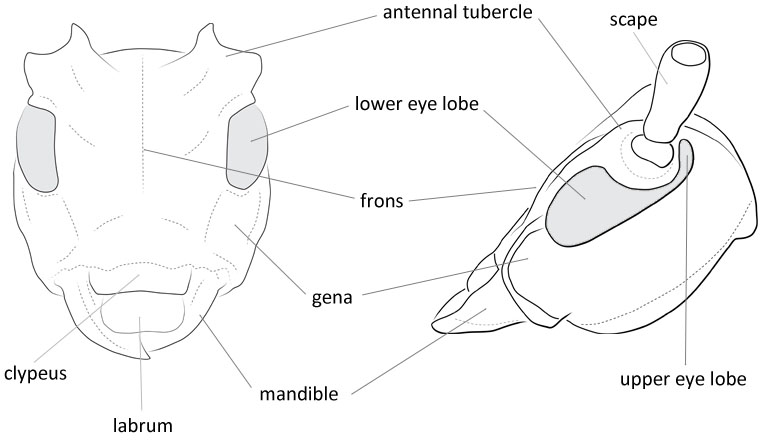Body length: 17–21 mm.
Eyes: eye interommatidial setaeseta:
a sclerotized hair-like projection of the cuticle
absent, eye deeply emarginateemarginate:
notched at the margin > half width, eye ommatidial density fine.
> half width, eye ommatidial density fine.
Antennaeantenna:
in larval and adult insects, paired segmented appendages, borne one on each side of the head, functioning as sense organs and bearing a large number of sensilla
: antennal length reaches between basebase:
the part of any appendage or structure that is nearest the body
and end of elytraelytron:
the leathery forewing of beetles, serving as a covering for the hind wings, commonly meeting opposite elytron in a straight line down the middle of the dorsum in repose
or reaching/surpassing end of body, antennal flagellar segments elongateelongate:
much longer than wide
, scapescape:
the first proximal segment of the antenna smooth/punctate at apexapex:
smooth/punctate at apexapex:
end of any structure distad to the base
, antennal segment 3 > scapescape:
the first proximal segment of the antenna .
.
Pronotumpronotum:
the upper and dorsal part of the prothorax
: pronotumpronotum:
the upper and dorsal part of the prothorax
shape transversetransverse:
broader than long
, pronotumpronotum:
the upper and dorsal part of the prothorax
lateral armature absent, rarely blunt tubercule.
Prosternum: prosternal processprosternal process:
a posterior extension of the prosternum between the coxae dilated at apexapex:
dilated at apexapex:
end of any structure distad to the base
or not dilated at apexapex:
end of any structure distad to the base
, procoxal cavities open posteriorly.
Elytraelytron:
the leathery forewing of beetles, serving as a covering for the hind wings, commonly meeting opposite elytron in a straight line down the middle of the dorsum in repose
: elytral length reaching or close to end of abdomen, elytral apicesapex:
end of any structure distad to the base
rounded or truncatetruncate:
cut off squarely at the tip
, elytral color pattern present.
Legs: visible tarsomerestarsomere:
subdivision or article of the tarsus, usually numbering from two to five : 4, femora clavateclavate:
: 4, femora clavateclavate:
thickening gradually toward the tip
, protibial spursprotibial spur:
sclerotized spine(s) located at the distal tibia; can be single, double, or absent : 2, tarsal clawstarsal claw:
: 2, tarsal clawstarsal claw:
usually paired claws of the pretarsus, at the distal end of the leg simple.
simple.
Form elongateelongate:
much longer than wide
, somewhat depressed. Head moderate; antennaeantenna:
in larval and adult insects, paired segmented appendages, borne one on each side of the head, functioning as sense organs and bearing a large number of sensilla
11-segmented, third segment a little longer than fourth; eyes not embracing antennal insertion. Pronotumpronotum:
the upper and dorsal part of the prothorax
dull, prosternum with intercoxal process narrow, at most slightly expanded behind coxae; mesonotum with a large, impunctate medial stridulatory area; posterior coxae prominent; metasternum with scent pores. Elytraelytron:
the leathery forewing of beetles, serving as a covering for the hind wings, commonly meeting opposite elytron in a straight line down the middle of the dorsum in repose
usually with elevated ivory-like costae. Legs very elongateelongate:
much longer than wide
; femora strongly clavateclavate:
thickening gradually toward the tip
, posterior pair exceeding elytral apicesapex:
end of any structure distad to the base
in male (Linsley 1963Linsley 1963:
Linsley EG. 1963. The Cerambycidae of North America. Part IV. Taxonomy and Classification of the Subfamily Cerambycinae, Tribes Elaphidionini Through Rhinotragini. University of California Publications in Entomology, Vol. 21. 165 pp.).
The ivory costae on elytraelytron:
the leathery forewing of beetles, serving as a covering for the hind wings, commonly meeting opposite elytron in a straight line down the middle of the dorsum in repose
and strongly clavateclavate:
thickening gradually toward the tip
femora distinguish this genus.
Nearctic
Taxodium; Ulmus americana, Quercus
3 species. Conifer feeder is P. andreae on Taxodium.
Dularius Thomson, 1860
Physocnemum Haldeman, 1847